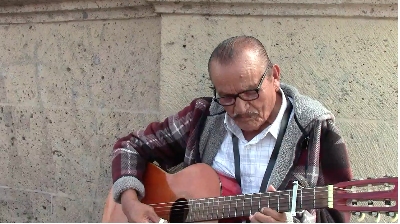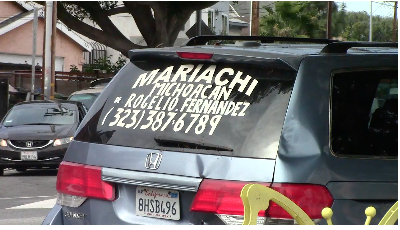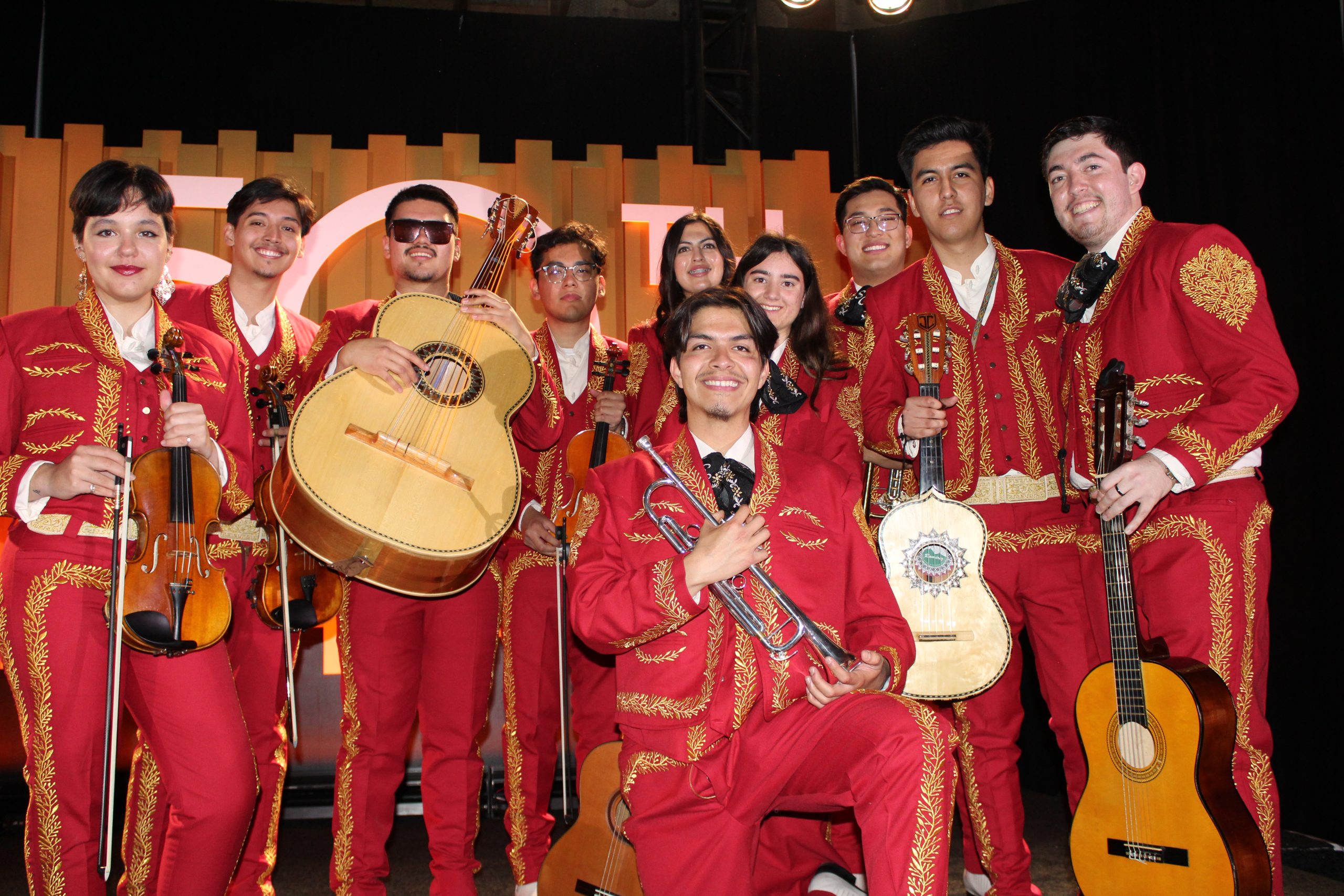In spite of numerous struggles new generations continue the love for Mariachi music
By José Romo
A thirty-minute ride connects the downtown Los Angeles area with the vibrant Boyle Heights community. Upon walking out of the underground metro station you are welcomed by a sight of murals, construction, and most importantly, the sound of mariachi music.
Staple of Mexican culture, La Plaza del Mariachi or Mariachi Plaza serves as the anchor point of tradition for musicians of all backgrounds to gather in hopes of earning a day’s work through their craft. Walking through the plaza you see numerous trucks; all with phone numbers painted on the back window asking greatly to be hired for gigs. Mariachis sit patiently on the plaza benches playing cards, others use this time to rehearse some music, some even leave in a hurry trying to beat traffic in order to attend their latest jobsite.
The weekends hold the highest likelihood for mariachis to be hired. Most families host parties; weddings, baptisms, birthdays and even simple family gatherings. All of these events all need live music and for those with great musical taste mariachi music is perfect. While most mariachis look to find gigs, some find it nice to just go to the plaza and play their music.
Teodoro Cuevas, owner of Mariachi Estrella del Sur, finds himself needing to share his knowledge to future generations of mariachi musicians. “La verdad no soy maestro pero se tocar. Tengo mi grupo de mariachi,” said Cuevas, humbly alluding to his own mariachi by telling us all he likes to jam to the rhythm of his guitar. After coming to the US in 1970 Cuevas began to work in the trucking industry. He recalls not ever considering a career in music since none of his siblings played an instrument.
Upon retirement, Cuevas found himself in a pickle; sit back and watch time pass or enjoy the music of mariachi. At 65 years old, Cuevas started to learn how to play the guitar. Now he totals the knowledge of four different instruments; the guitarron, the vihuela, the requinto and of course the guitar. “Yo trabaje en Los Ángeles hasta mi retiro de vejez y nunca toque un instrumento. Pero ya vez que dicen el hambre es el que tumba y el orgullo levanta,” Cuevas joked saying that hunger is quick to drop you, but it is your pride that picks you back up. His solution at the time was to do what he continues to do to this day, pull up a chair and play with his friends. “Empecé a venir aquí y fui aprendiendo y ahora resulta que tengo mi propio mariachi,” Cuevas added that he learned from the musicians he would meet at the plaza.
That is how the majority of mariachi music is passed on. Many mariachis have multiple generations backing their legacy. Grandparents teach their children who then teach their kids continuing the chain of musicians. While Cuevas is an exception to this motif he still sees this happening within the community he is in. Feeling proud that this tradition continued Cuevas said, “Yo estoy mirando que muchos mariachis están entrenando a sus hijos. Es una gran alegría porque así no se perderá la costumbre.”
“Pienso que todos los que sabemos el arte pasamos por dificultades. Los compañeros te hacen menos, pero la persistencia es la que cuenta,” he said. Cuevas told me that often his concerns stem from the lack of lighting in the streets of Boyle Heights. There are times he feels unsafe, he says. He then closed by saying that some mariachis even take business competition as far as to tell clients that certain mariachis are not worth the investment. However, the continuation of the mariachi tradition is not all that Cuevas has in mind. The community as a whole faces a growing housing crisis.
In 2018, mariachis found themselves struggling to make ends meet after their rent was spiked. Cuevas recalls that when he first moved to East Los Angeles rent prices were completely different. “En ese edificio que estaba ahí viven la mayor parte de mariachi y pagaban 400, 300. Ahora está muy caro porque se remodelaron y pues ya no viven mariachis. Ya no cualquier persona puede pagar 1400,1300,” he said. Jaime Gomez, who was sitting with Cuevas for a lesson while we were doing the interview, told us he worked in the remodeling of the building where Monarca Bakery sits now. “Lo cambiamos todo y ahora hay menos apartamentos,” said Gomez in a remorseful tone to the changes that now leaves his own community with less housing.
Located on East Second street, the building served as more than just a roof for mariachis, it was a music sanctuary. Cuevas recalls his own experience with the housing crisis. “En ese tiempo había más facilidad. Yo vivo en el este de Los Ángeles. Ya se empezaron a escanciar (las viviendas),” said Cuevas. Back then, Cuevas was able to delve into the realtor business as both a homeowner and a landlord. He bought a small house and then purchased two small joint apartments he began to rent off in Hoover and Adams. “Cuando llegué, empecé con 2000 dólares y vi que estaban muy baratas las casas. Entonces entre Adams y Hoover yo compre unos apartamentos por 90 mil.” For Cuevas, his early investment made it easier for him to continue his run at mariachi music.

Upon retirement, Cuevas found himself in a pickle; sit back and watch time pass or enjoy the music of mariachi. At 65 years old, Cuevas started to learn how to play the guitar. Now he totals the knowledge of four different instruments; the guitarron, the vihuela, the requinto and of course the guitar. “Yo trabaje en Los Ángeles hasta mi retiro de vejez y nunca toque un instrumento. Pero ya vez que dicen el hambre es el que tumba y el orgullo levanta,” Cuevas joked saying that hunger is quick to drop you, but it is your pride that picks you back up. His solution at the time was to do what he continues to do to this day, pull up a chair and play with his friends. “Empecé a venir aquí y fui aprendiendo y ahora resulta que tengo mi propio mariachi,” Cuevas added that he learned from the musicians he would meet at the plaza.
“Pienso que todos los que sabemos el arte pasamos por dificultades. Los compañeros te hacen menos, pero la persistencia es la que cuenta,” he said. Cuevas told me that often his concerns stem from the lack of lighting in the streets of Boyle Heights. There are times he feels unsafe, he says. He then closed by saying that some mariachis even take business competition as far as to tell clients that certain mariachis are not worth the investment. However, the continuation of the mariachi tradition is not all that Cuevas has in mind. The community as a whole faces a growing housing crisis.
In 2018, mariachis found themselves struggling to make ends meet after their rent was spiked. Cuevas recalls that when he first moved to East Los Angeles rent prices were completely different. “En ese edificio que estaba ahí viven la mayor parte de mariachi y pagaban 400, 300. Ahora está muy caro porque se remodelaron y pues ya no viven mariachis. Ya no cualquier persona puede pagar 1400,1300,” he said. Jaime Gomez, who was sitting with Cuevas for a lesson while we were doing the interview, told us he worked in the remodeling of the building where Monarca Bakery sits now. “Lo cambiamos todo y ahora hay menos apartamentos,” said Gomez in a remorseful tone to the changes that now leaves his own community with less housing.
Located on East Second street, the building served as more than just a roof for mariachis, it was a music sanctuary. Cuevas recalls his own experience with the housing crisis. “En ese tiempo había más facilidad. Yo vivo en el este de Los Ángeles. Ya se empezaron a escanciar (las viviendas),” said Cuevas. Back then, Cuevas was able to delve into the realtor business as both a homeowner and a landlord. He bought a small house and then purchased two small joint apartments he began to rent off in Hoover and Adams. “Cuando llegué, empecé con 2000 dólares y vi que estaban muy baratas las casas. Entonces entre Adams y Hoover yo compre unos apartamentos por 90 mil.” For Cuevas, his early investment made it easier for him to continue his run at mariachi music.
How to connect with Mariachi
- Organización de Mariachis Independiente de California
- Showcase your projects.
- Experience the world of architecture.


Mariachi Los Troyanos
- The goal is to highlight Mexican culture at USC.
- Rehearses every Tuesday and Thursday at 8pm.
- Follow on Instagram @mariachi_usc
Continuing the Legacy
Being from Jalisco, mariachi music runs through my veins. It was always my dream to form part of a mariachi and in my sophomore year of college I decided to join with other students in creating Mariachi Los Troyanos de USC. Three years later, this club has not only won awards and gained recognition, but it also turned into a family that prides itself on highlighting our Mexican heritage. As I move closer to graduation I look at the future Troyans who will continue this legacy.
Similarly, professional Mariachis continue their own legacies having generations on generations practicing the tradition of their music. That is how the majority of mariachi music is passed on. Grandparents teach their children who then teach their kids continuing the chain of musicians. While Cuevas is an exception to this motif he still sees this happening within the community he is in. Feeling proud that this tradition continued Cuevas said, “Yo estoy mirando que muchos mariachis están entrenando a sus hijos. Es una gran alegría porque así no se perderá la costumbre.”
Some like Eduardo Cardenas, are a third generation mariachi keeps this music alive. “QUOTE ABOUT WHY HE LIKES MARIACHI.”
Leave a Reply